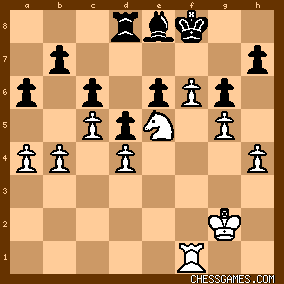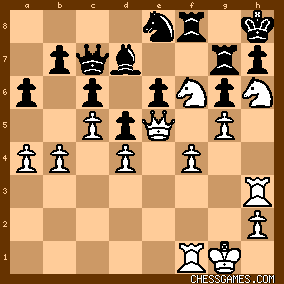|
< Earlier Kibitzing · PAGE 3 OF 3 ·
Later Kibitzing> |
| Aug-19-15 | | morfishine: <Adbel Irada> The 'Butterfly Effect' ? |
|
| Aug-19-15 | | Imran Iskandar: Really nice game. I like the fact that Schlechter had the power to push his kingside pawns to barrage his opponent's king knowing full well that none of Black's pieces could slip through and harass the White king. |
|
| Aug-19-15 | | thegoodanarchist: Am I the only one who thinks the pun is awful? |
|
| Aug-19-15 | | kevin86: The "stalled" attack opens up on the queen side with a pawn thrust! |
|
| Aug-19-15 | | tonsillolith: I undon my hat to the creator of today's pun. |
|
| Aug-19-15 | | mrknightly: Not too schlect, if I do say so. |
|
Aug-19-15
 | | HeMateMe: great game, not sure if get the pun. |
|
| Aug-19-15 | | CommaVid: This game is very well played, white manages to improve his position almost every single move. |
|
Aug-19-15
 | | HeMateMe: A mistake I make in playing this opening with white is im worried about trading bishops on the f file, getting doubled pawns. Because the pawn block is still strong, the doubled f pawns don't really matter, and black's bad bishop is still sealed in. Textbook play on how to strangle a position with a locked in bishop. |
|
| Aug-19-15 | | BOSTER: This is pos. white to play 47.

click for larger view
My Q is:
Does white really need another half of the board (queen's side) to win this game playing f7
and h5? |
|
| Aug-19-15 | | RookFile: The opening was strange. White plays 5. Bf4 and black responds with ...Bd6. I know that sometimes it's ok for black if white gets in this swap of dark squared bishops, but in this case black went out of his way to make it happen. |
|
| Aug-19-15 | | johnlspouge: @<BOSTER>: No. After moving the White K to f4, I tried the plan [1].h5 gxh5
[2].g6 hxg6
[3].Kg5 any
[4].Nxg6 Bxg6
[5].Kxg6
and Stockfish had to give up the Black R and lose. |
|
| Aug-20-15 | | Abdel Irada: In a sense, <morfishine>. Except here, as is not so clear with Chaos Theory, it is really demonstrable that the whole board is an interlocking whole, and a modest move on one side of the board can often produce profound consequences on the other. Of course, this point is much more obvious in the case of Go, where the difference between a 4-4 and a 4-3 opening (both fairly popular ways to begin a game) suddenly turns out to be important, many moves later, when one side either can link to the resulting structure in that area or not, or when the opponent can or cannot invade and construct a living group inside that structure. ∞ |
|
| Aug-20-15 | | morfishine: <Adbel Irada> Yes, GO is a fascinating game. I only first played GO a few years ago and don't really understand all the rules, but it really is interesting. Curiously, at least for me, the Wiki article does a better job explaining all the rules than the actual rule book that came with my game: https://en.wikipedia.org/wiki/Go_%2... ***** |
|
| Aug-20-15 | | BOSTER: <John: 1.h5>.
NO. 1.f7.
I don't move white King.
Try again, please. |
|
| Aug-21-15 | | Abdel Irada: Must be something wrong with the Chess Viewer.
In the final position, Black's pawn on f7 looks swollen and deformed, and its head looks pointier than it ought. ∞ |
|
| Sep-04-15 | | DarthStapler: Does anyone know any games with a decisive move on b8? Because I want to submit one with the pun "Gr8 b8 m8" |
|
Sep-04-15
 | | beatgiant: <DarthStapler>
Lots of them, Alekhine vs Reshevsky, 1937 35. Rxb8+ for one famous example. |
|
| Sep-18-15 | | Andratos95: Why did black play Na6 on move 18? Since white's knight on e5 is so good, what is wrong with Nd7, which challanges it? |
|
Sep-18-15
 | | beatgiant: <Andratos95>
Welcome to the site.
On 18...Nd7, White replies 19. Qe7 and wins some material. |
|
| Nov-19-19 | | Swedish Logician: Jon Speelman, in his Best Chess Games 1970-1980, pointed to this game
Miles vs Ulf Andersson, 1980
as a late descendant of Schlechter's technique. |
|
Nov-19-19
 | | FSR: A classic masterpiece. |
|
Aug-21-21
 | | GrahamClayton: As well as the white knights making use of e5, both of them on f6 and h6 at the same time is also pretty neat:
click for larger view |
|
Dec-18-21
 | | kerpa: This game is beautifully explained with great clarity by Fred Reinfeld in Chess Review March 1943 p. 89 - 91. It is Part Two of Chess Openings Made Easy, in which Reinfeld explains openings and also their relationships to middle games on the basis of pawn structures (he called them formations) characteristic of a given opening. You can access this article for free from Chess Life web site digital archives. |
|
| May-05-24 | | mk volkov: The Knight Without Fear and Beyond Reproach |
|
 |
 |
|
< Earlier Kibitzing · PAGE 3 OF 3 ·
Later Kibitzing> |





